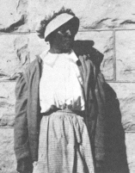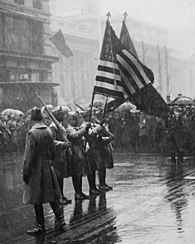Cathay Williams
Cathay Williams | |
|---|---|
 | |
| Born | September 1844 |
| Died | 1893 (aged 50–51) |
| Other names | John Williams, William Cathay |
| Occupation(s) | Soldier, cook, seamstress |
| Employer(s) | U.S. government, self-employed |
| Military career | |
| Allegiance | |
| Years of service | 1866–1868 |
| Rank | private |
| Unit | 38th U.S. Infantry Regiment, U.S. Army (Buffalo soldier) |
Cathay Williams (September 1844 – 1893) was an American soldier. An African-American woman, she enlisted in the United States Army under the pseudonym William Cathay. Williams became the first female to enlist and the only documented woman to serve in the U.S. Army while posing as a man during the Indian Wars.[1]
Early life
[edit]Cathay Williams was born in September 1844 in Independence, Missouri to a free man and a woman in slavery, making her legal status also that of a slave. During her adolescence, Williams worked as a house slave on the Johnson plantation on the outskirts of Jefferson City, Missouri. In 1861 Union forces occupied Jefferson City in the early stages of the Civil War. At that time, captured slaves officially were designated by the Union as contraband, and many were forced to serve in military support roles such as cooks, laundresses, or nurses.
U.S. Army service
[edit]
Because of the prohibition against women serving in the military, Cathay Williams enlisted in the United States Regular Army under the false name of William Cathay[2] on November 15, 1866 at St. Louis, Missouri for a three-year engagement, passing herself off as a man. She was assigned to the 38th United States Infantry Regiment after she passed a cursory medical examination.[2] Only two others are known to have been privy to the deception, her cousin and a friend, both of whom were fellow soldiers in her regiment. She is believed to be the first black woman to be awarded the Good Conduct Medal.
Shortly after her enlistment, Williams contracted smallpox, was hospitalized and later rejoined her unit, which by then was posted in New Mexico. Possibly due to the effects of smallpox, the New Mexico heat, or the cumulative effects of years of marching, her body began to show signs of strain. She frequently was hospitalized. The post surgeon finally discovered she was a woman and informed the post commander. She was discharged from the Army by her commanding officer, Captain Charles E. Clarke, on October 14, 1868.
Post-military service years
[edit]Cathay Williams worked as a cook at Fort Union, New Mexico and later moved to Pueblo, Colorado. She married, but it ended disastrously when her husband stole her money and a team of horses. Williams had him arrested.
She moved to Trinidad, Colorado, where she worked as a seamstress. She may also have owned a boarding house. It was at this time that Williams' story first became public. A reporter from St. Louis heard rumors of an African-American woman who had served in the army, and he came to interview her. Her life and military service narrative was published in The St. Louis Daily Times on January 2, 1876.

In late 1889 or early 1890, Williams entered a local hospital where she remained for some time, and in June 1891, applied for a disability pension based on her military service. The nature of her illness and disability are unknown. There was precedent for granting a pension to female soldiers. Deborah Sampson in 1816, Anna Maria Lane, and Mary Hayes McCauley (better known as Molly Pitcher) had been granted pensions for their service in the American Revolutionary War.
Declining health and death
[edit]In September 1892, a doctor employed by the U.S. Pension Bureau examined Cathay Williams. Despite the fact that she suffered from neuralgia and diabetes, resulting in the amputation of her toes, and could only walk with a crutch, the doctor decided she did not qualify for disability payments. Her application was rejected.[3][4]
The exact date of Williams' death is unknown, but it is assumed she died shortly after being denied a pension, probably sometime in 1893. Her grave marker is likely to have been made of wood and deteriorated long ago. Thus her final resting place is unknown.
Honors
[edit]In 2016, a bronze bust of Cathay Williams, featuring information about her and with a small rose garden around it, was unveiled outside the Richard Allen Cultural Center in Leavenworth, Kansas.[5]
In 2018, the Private Cathay Williams monument bench was unveiled on the Walk of Honor at the National Infantry Museum.[6]
See also
[edit]- African-American firsts
- List of wartime crossdressers
- The Harder They Fall, a 2021 revisionist Western film in which Danielle Deadwyler portrays Cuffee, a transgender man modeled after Williams.[7]
References
[edit]- ^ Tucker, Phillip Thomas (2002-01-01). Cathy Williams: From Slave to Female Buffalo Soldier. Stackpole Books. ISBN 9780811703406.
- ^ a b Pennington, Reina (2003). Amazons to Fighter Pilots – A Biographical Dictionary of Military Women. Westport, Connecticut: Greenwood Press. pp. 482–483. ISBN 0-313-32708-4.
- ^ Voices of the Buffalo Soldier: Records, reports, and recollections of military life and service in the West. Edited by Frank N. Schubert. Albuquerque: University of New Mexico Press, 2003, p. 33.
- ^ Disapproved Pension Application File for Cathay Williams (aka William Cathay), 38th U.S. Infantry Regiment, Company A (SO-1032593). Series: Case Files of Disapproved Pension Applications of Veterans of the Army and the Navy Who Served Mainly in the Civil War and the War with Spain, ca. 1861 - ca. 1934. 1934. Archived from the original on 2016-10-23.
- ^ Davismirandadavis, Miranda (2016-07-22). "Monument to female Buffalo Soldier is dedicated in Leavenworth | The Kansas City Star". Kansascity.com. Retrieved 2016-07-30.
- ^ Gunn, Olivia (17 February 2018). "Buffalo Soldiers honor first female, documented U.S. Army soldier". WTVM. Retrieved 8 April 2020.
- ^ Zacharek, Stephanie (October 6, 2021). "The Harder They Fall Fails to Make Enough Room for Each Star Among Its Stellar Cast". Time. Archived from the original on October 28, 2021. Retrieved November 4, 2021.
Sources
[edit]- "Profiles in Courage: Cathay Williams aka William Cathay". Heroes Among Us. United States Army. 2008. Archived from the original on 2008-06-16. Retrieved 2008-11-13.
- Ramona L. Rand-Caplan, ed. (2008). "Williams, Cathay (1850– )". African American History in the American West. BlackPast.org. Retrieved 2008-11-13.
- Stanford L. Davis (25 June 2006). "Female Buffalo Soldier- With Documents". Buffalo Soldier.net. Retrieved 2007-07-30.
- "William Cathay". African-American News & Issues. 3 September 2005. Archived from the original on 27 September 2007. Retrieved 2007-01-15.
- Shane McCrae (2012). "The Ballad of Cathay Williams William Cathay". Poets.org. Retrieved 2012-11-27.
- Cathay Williams: Female Buffalo Soldier Archived from the original. Sources pertaining to Cathay Williams' life compiled by the National Park Service
Further reading
[edit]- Glasrud, Bruce; Searles, Michael (2007). Buffalo soldiers in the West : a Black soldiers anthology (1st ed.). Texas A & M University Press: College Station, Tex. ISBN 978-1-60344-449-1. OCLC 607825144.
External links
[edit]- 1844 births
- 1893 deaths
- African-American female military personnel
- People from Independence, Missouri
- African Americans in the American Old West
- African Americans in the American Civil War
- American chefs
- 19th-century American slaves
- Buffalo Soldiers
- People of Missouri in the American Civil War
- Female wartime cross-dressers in the American Civil War
- 19th-century African-American women
- African-American United States Army personnel
- 19th-century African-American people
- 19th-century American women
- Colorado pioneers

